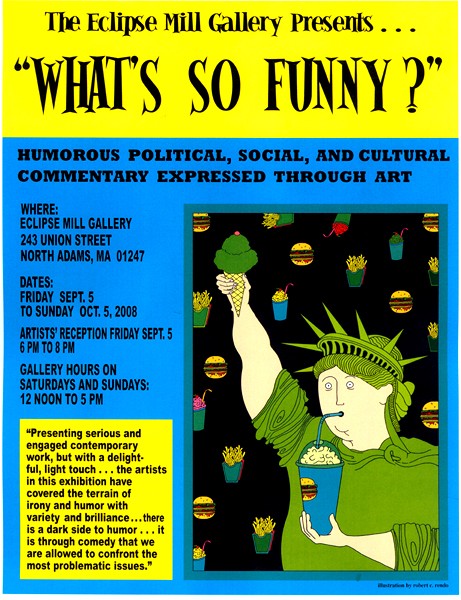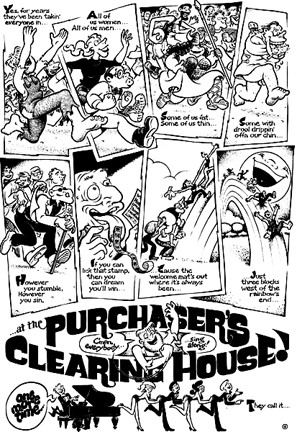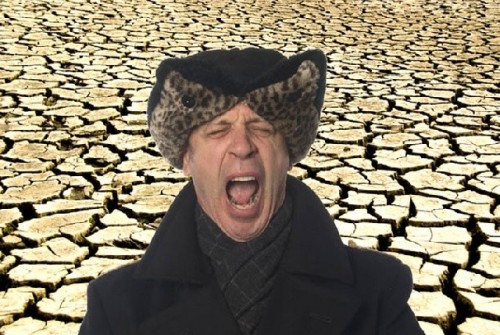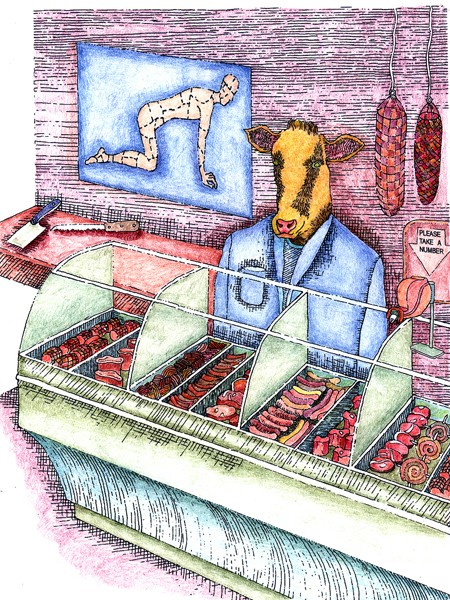What's So Funny at Eclipse Mill Gallery
North Adams Exhibition Explores Humor in Art
By: Charles Giuliano - Sep 10, 2008
What's So Funny
Eclipse Mill Gallery
243 Union Street
North Adams, Mass. 01247
Through October 5
Curated by Charles Giuliano
Artists: Larry Alice, Richard Criddle, Howard Cruse, Alan P. Hayes, Joan Kiley, Bruce Koscielniak, Robert Rendo, Norman Thomas.
Gallery Hours: Saturday and Sunday, 1 to 5 pm
It is better to laugh than cry. When faced with tragedy, disaster, and adversity it is a human instinct to seek release through humor. With incredible speed after the most horrific news is conveyed by the media jokes begin to circulate. They are often conveyed in hushed tones between friends and acquaintances sharing guilty pleasure.
Some years back I learned of the death of my father. It was quite sudden and far away in Florida. For three days I hibernated and experienced the grieving. I put on a stack of gospel and blues LPs. They offered comfort and insight. After several days it was time to return to the rhythm of daily life. On the turntable I stacked up albums by Lenny Bruce and Lord Buckley. Their irreverent hipster humor provided an ironic mood to ease me out of that dark inner voyage. The wit of acerbic comedy was every bit as apt and comforting as had been Mahalia Jackson, the Five Blind Boys of Mississippi, or Bessie Smith. I came to deeply appreciate the healing powers of the darkest comedy. .
Despite its position in the dichotomy of human emotion, in the arts, comedy has always enjoyed less status than tragedy. This was first argued in the "Poetics" of Aristotle in the 5th century B.C. The philosopher in discussing the great playwrights of Classical Greece ranked the tragedies of Sophocles of greater artistic importance than the comedies of Aristophanes. Looking back at past generations, for example, the great tragic actors are celebrated while equally brilliant comedians are less revered.
Recently, we watched Frank Capra's 1944 film "Arsenic and Old Lace." Once again we were reminded of the brilliant comic timing of Cary Grant. He was an absolute master of the light touch required by screwball comedy. On many levels he was on the short list of the greatest actors of his generation. Grant was twice nominated for an Oscar and both times for dramatic roles. His only Academy Award came for Lifetime Achievement in 1970.
In recent years there has been a tidal wave of contemporary art dealing with social and political issues. Much of this has been sincere if a bit shrill and strident. It has been the mother's milk of an emerging generation of outraged artists, curators and critics. Often the work preaches to the converted telling us what we already know. Those who are interested in contemporary art tend, by definition, to be liberal. So much of this effort fails to reach or involve the conservative base.
Within a day of the nomination of Sarah Palin as the Vice Presidential candidate for the Republican Party, for example, the jokes began to fly. One image rapidly circulated through e mail depicted her in the back yard next to the pool in an American flag bikini wielding an AK 47. The automatic rifle is just what you need in the frozen North to bring down a randy moose. Sure it was funny but far less amusing than the jump in the polls for the pistol packing, pit bull with lipstick, soccer mom from Alaska.
The artists in the exhibition "What's So Funny" at the Eclipse Mill Gallery through October 5 are deadly serious about the issues they deal with but the work is hilarious. It is unique to walk into a gallery and have a good laugh. With a couple of exceptions, however, the artists weren't particularly striving to be funny. It took some effort and persuasion to convince several of the artists to participate in this project.
Often curatorial projects evolve over time. We see the work of an artist and intend one day to include it in an exhibition. It is a matter of finding the right occasion and synergy. As we see new work there is a process where we start to connect the dots. The images of this artist seem to match up with that one. What is the commonality? How to convince these individuals that it is to their advantage to be placed in a context with several artists. Often artists want to know who are the other participants and what is the point being made. Once a theme is established you start to add on and consider other artists. This can be quite serendipitous as proved to be the case for his show. Once a show opens, typically, people seem to get the point and suggest artists who might have been included. One interesting project can stimulate another and another. The next curator strives to correct the mistakes of the first one. Ambitious curators make the rounds.
Some time back I wrote about Richard Criddle's exhibition in Kidsspace at Mass MoCA. The enormous assemblage sculptures seemed cramped into a multi functional space. It was hilarious to talk with him about the source for such works as "Miss Cartwright" which has been installed in the Eclipse Gallery. Many of the works were inspired by the monsters he encountered as a child with a vivid imagination growing up in England. It struck me that his work would be perfect for this project with an opportunity to have it seen in a larger space.
Once that decision was made there were logistical issues about where to place such a large and dominant work. The artist visited the space and we agreed on where to place it. Then it became a matter of of finding the time to install it considering the demands of his schedule. Amazingly it all fell in place perfectly.
Thinking of the theme of humor I wanted to include the Provincetown based artist Jay Critchley. I have followed his work with great interest over many years. When I contacted him we discussed how to get the work to the Berkshires. The "Global Yawning for a Small Planet Series" comprised several, billboard scaled, digital prints that were included in an exhibition at the Boston Center for the Arts. Because of the expense of shipping and handling it was out of the question. But I asked would he be willing to put the images onto a disk. With just the cost of postage I could then print several images on my Epson 2200 at 13 x 19" and mount them with glass and gallery clips. That worked and it was great to include Critchley in the show. One nice result of this collaboration was a feature interview on the artist by John Mitchell in the North Adams Transcript. He aptly brought out all of Jay's quirks and insights. There was also an in depth feature on the exhibition in the Advocate by its editor Rebecca Dravis.
It is interesting to interact with artists who don't normally exhibit their work. In this instance that included an editorial cartoonist and illustrator, Robert Rendo, the cartoonist, Howard Cruse, and an author of illustrated children's books, Bruce Koscielniak. With these artists it was a matter of convincing them that they were appropriate for the project and then dealing with how to display their work.
Meeting with Cruse he presented several stacks of drawings and illustrations. We went through these together finding a series that would work in the space allotted to him in the group show. We settled on a series that humorously is inspired by the Publisher's Clearing House prizes. It also entailed a song and during the exhibition there is a CD player and head set for visitors to hear the amusing jingle. The meeting occurred just before Howard was about to leave for a cartoon convention in Spain. So we had to agree on a selection or work and pr materials before his departure. We settled on glass and gallery clips as a cost effective means of display. This was new to him as his cartoons usually appear in print and not on the wall.
When we installed the series of drawings they looked great but Howard cut his fingers several times while handling the glass. What a trooper. We moved on while someone went off to get a Band-Aid. He was a great sport also to help me install a grid of nine digital images by Rendo. We worked so well together I would have been in a bind without him.
There were ongoing dialogues with Rendo about how best to display his work. He is currently working on a catalogue of literally hundreds of variations of several series of illustrations. I was reluctant to take on selecting from such a vast body of work. So I asked Robert to make a cut down to three sets of images, three each, in a grid of nine. This would provide a glimpse of the oeuvre. Again, as he normally works with editorial and print media, he was new to the requirement of exhibiting the illustrations. We collaborated to produce a set of digital prints to be mounted with glass and clips.
The nine images by Rendo are hilarious but also thought provoking. He goes for the jugular of contemporary issues but with a humorous twist. The topics he covers range from America's trend toward obesity to its unquenchable thirst for energy. An anthropomorphic steer behind the counter of a butcher shop sells choice cuts of human flesh. Good heavens what a carnivorous nightmare. It is enough to turn us all into vegetarians.
During the "Berkshire Salon" exhibition I met the illustrator Bruce Koscielniak. Discussing the theme of the show I asked if he had work that we would consider to be funny. The initial response was not really. After thinking about it he got back to me and proposed to develop a project that had been on his mind for some time. This resulted in a series of drawings and ersatz news reports on an alleged 1947 UFO sighting in his home town of Adams, Mass. The illustrated story has been a real hit with visitors to the gallery.
While gallery sitting, an artist from Pittsfield, Alan P. Hayes, walked in with a portfolio. He was visiting the studio of a resident in the mill complex. I asked to see his work. After viewing several series of digital photographs, many of which I found amusing and witty, I asked if he thought of his work as funny? I invited him to consider being in the show that I was organizing Alan thought about it and started looking through his work from this point of view. With enormous enthusiasm he narrowed the search and reprinted a number of works to exhibition standards. We met and looked through a number of images before deciding on the grid of nine, framed works in the exhibition. When you sort for humor it proved to be a consistent element of the work although Hayes stated that he had never really thought of it as his primary intention. The focal point of the series proved to be his "Self Portrait in a Cow's Trough." He offered to bring in the metal trough and install it in the gallery. But we graciously declined his suggestion to demonstrate a working class hot tub.
In a one man show at the Eclipse Mill Gallery last year some of the paintings of Larry Alice entailed elements of cartooning and popular culture. Coming relatively soon after that in depth exhibition he was reluctant to show paintings that had already been seen. As we approached the deadline for the exhibition he submitted a new piece being seen here for the first time. It is indeed hilarious and typically multi layered. Alice is a serious painter who likes to draw on multiple sources simultaneously. There are squiggley, cartoonish markings in the lush abstract painting. Over the top humor is conveyed by the punch line of a text with his ironic take on the frustrations of relationships. The painting, like Richard Prince's jokes, has a post modern twist.
Humor is a consistent element in the paintings of the couple Norm Thomas and Joan Kiley. Over the past few years they have both been working with complex compositions entailing many elements of images. Joan includes aspects of hand written text. Norm had previously worked on a series of abstract paintings as a means to work out the cubist layering of images in his current work.
This is what I anticipated when I included Norm in this show. But he wants to hold back the new work in progress to show it all at once. So he submitted a couple of older works from a series of humorous portraits including a "Generallisimo" and a corporate type. On the wall label I mistakenly stated that the paintings were acrylic on canvas. Norm was amused to point out that it would have been impossible to get those broad, sliding, gestural strokes with anything other than oil paint.
In a small monotype Kiley depicts a nude woman riding a bicycle. If not exactly a self portrait the persona of the artist is usually an element in the work. As is the case with her reflection on aspects of glamour and lingerie inspired by Victoria's Secret or memories of Buddy Holly.
Visitors to this witty exhibition will leave with smiles on their faces but also a lot to think about. Or, as Cole Porter conveyed with irony "I've got you under my skin."











